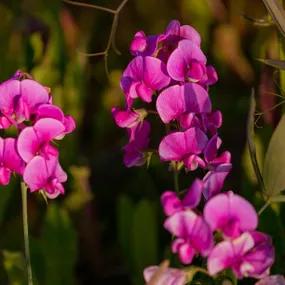Red Pearl Perennial Sweet Pea Seedlings
The details
Lathyrus latifolia
- Colour: Red
- Climber or Ground cover
- Height: 2m
- Type: Everlasting / Perennial
- Scent: Little to none
- Flowering: June to September
- RHS Plants for Pollinators
Recommended extras
Description
Lathyrus latifolius 'Red Pearl' Everlasting / Perennial Sweet Pea Plants
Move over O'Hara, this scarlet sweetie is the only one in town.
What perennial sweet peas lack in scent, they make up for with vigour and staying power, flowering from mid summer right through to September, and reappearing every year. Insects, especially butterflies, are well supplied by them, as will be your cut-flower displays.
Browse our other perennial plants, or our annual sweet peas.
Features
- Colour: Red
- Climber or Ground cover
- Height: 2m
- Type: Everlasting / Perennial
- Scent: Little to none
- Flowering: June to September
- Planting Months: March-June
- RHS Plants for Pollinators
Growing Perennial Sweet Peas
Everlasting sweet peas are drought tolerant and the only maintenance required is to cut down the whole plant to the ground once it has finished flowering in autumn. Everlasting sweet peas are hardy and do not need any protection during winter. Grow them up a support for the best display of flowers, or let them sprawl and set seeds as wildlife-friendly ground cover.
All sweet peas are leguminous, so their roots fix nitrogen from the air into the soil, which becomes available to neighbouring plants over time. Extremely easy to please, they can grow like a weed (to the point of being invasive) in any moderately fertile soil with a decent amount of sun.
To prevent them from spreading, either deadhead the flowers, or remove the seedpods while they are still green; when they turn brown and dry out, they will split and flick their seeds a short distance away.
In Your Garden Design
The brilliant red of this variety looks great scrambling up a wall or with a dark evergreen such as Italian Cypress behind it. These look fabulous in garden full of roses, delphiniums, stocks and digitalis or staked wigwam style surrounded by a low cut lavender or box hedge. Pair with other varieties of laythrus too.
Planting Instructions
Did You Know?
Lathyrus are native to Europe, and bumblebees are their primary pollinator. A sure way to tell the perennial L latifolius from annual sweet peas, L odoratus, is that the former has practically no scent; to make up for this, it is particularly attractive to the brimstone butterfly.
As with sweet peas, the seeds are not suitable for eating. They were used as a famine food in the past, but even in those desperate times people knew that they could only eat a small portion of them each day, mixed with other foods, or they would suffer from a range of permanent disabilities known collectively as lathyrism. Best to stick with your frozen peas for supper.


